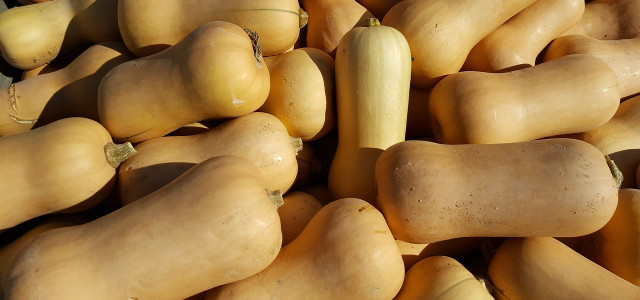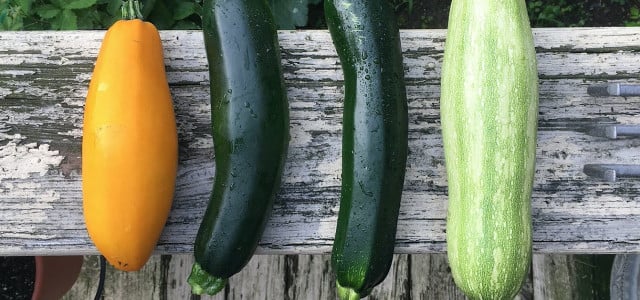If you want to know when to harvest butternut squash, you’re in the right place. We’ll provide some useful tips and tricks to keep in mind when during your harvest.
Butternut squash is often used in various recipes and is extremely versatile. It boasts many attractive nutritional benefits and is a great source of vitamin C, fiber, vitamin A, magnesium, and potassium. This makes it a great choice to incorporate into an existing meal or to cook on its own. The choice is all yours.
To obtain this tasty winter squash, you can either grow it yourself or purchase it. Growing your own is often advantageous from an environmental perspective, as it reduces transportation emissions, pollution, and the use of pesticides. Some individuals even find it more convenient to grow in their gardens. If you already grow your own, you may wonder when to harvest your butternut squash — and we’ve got the answers you’re looking for.
When to Harvest Butternut Squash

There are several giveaway signs that will help you to decide when to harvest your butternut squash. You should be able to familiarize yourself with these pretty quickly. If you’re a seasoned gardener, then you may find the whole process a breeze. Here is how you can tell if your squash is ready to harvest:
- It weights between two to three pounds
- The skin is an orange or tan color with no green
- The skin should also be very firm and hard
- Between 100 to 120 days have passed since first planting them
- The stems are brown and dry
If you’re not sure how to tell whether your butternut squash is hard, try pressing a fingernail in. If it’s ready for harvest, it shouldn’t puncture the skin at all. While butternut squash can generally be grown anywhere in the US, it does prefer climates that are humid and warm. They don’t like frost. This is why they are normally planted in late spring or early June. Harvesting when ripe will also ensure maximum flavor.
However, what about if you live in a hotter climate? If you happen to live in a warmer state, then you can plant your butternut squash in late May to early June too. However, you can plant as early as mid-February in some parts of Arizona. It all comes down to how much frost there is. They are typically ready to harvest around the month of September.
How to Harvest Butternut Squash



When it comes to harvesting your butternut squash, there are some useful tips you can utilize to get the best quality. Here is how to correctly harvest butternut squash:
- Use a sharp knife or secateurs to cut it from the vine. Make sure to leave anywhere between two to six inches of vine attached to the squash.
- Carry the butternut squash from the bottom, not where the stem is. This is important as harming or breaking the stem will impact the quality and shelf-life of the vegetable.
Once you’ve completed the harvesting process, you can prepare for curing before storing it. Butternut squash can typically keep for up to six months. This is great news, as it means you should have a good amount of produce to last you quite a while. So, how does the curing process work? Let’s take a look.
Curing and Storing Butternut Squash



Before curing your butternut squash, you should ensure that it is clean and free of any dirt, but don’t wash it with water. Once it’s clean, you can begin curing it. To cure the vegetable, simply place the vegetable in a warm space indoors or outdoors, preferably on an elevated rack, with a temperature between 80°F and 85°F. This warm temperature should be constant; you should never let it drop below 50°F. When it comes to humidity, keep it at 80 percent.
You should also ensure that the conditions are dry and that there is plenty of ventilation. These conditions will help to prevent rotting.
Once you have ensured these conditions can be met, leave your butternut squash to cure for between 10 and 14 days. During this period, you should ensure that no rot begins to appear on your produce. Any rotting vegetables should be moved away from the others. Preventing rotting and any potential food waste is important, as it prevents it from being sent to landfill where it can emit harmful greenhouse gases.
Storing your butternut squash is fairly straightforward. They should be stored between 50°F and 55°F stood next to each other between 50 to 70 percent humidity. If you store it correctly, it should last for up to six months. However, you could always choose to sustainably freeze your butternut squash.
Other Considerations to Make



If you live in a colder climate, then you may want to know what the best variety to plant is. Luckily, you have plenty of options. Some varieties that you may want to consider are Golden Nugget and Thelma Sanders Acorn. You could also consider Honeynut or Honeyboat.
However, if you do want to stick with butternut squash, there are some protective measures that you can take. You could also consider growing it in a greenhouse, but you will have to make sure that the correct temperatures are maintained. If you want to incorporate it into a recipe, you could try a winter squash soup.
Read more:
- An Overview of All Winter Squash Varieties and How To Use Them
- Can You Eat Squash Raw? Why It’s Not Always a Good Idea
- How to Harvest Rhubarb: Avoid These 5 Mistakes
Do you like this post?








